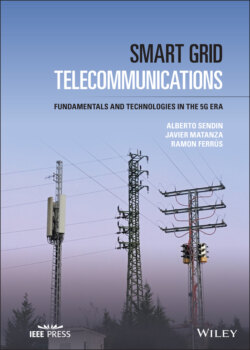Читать книгу Smart Grid Telecommunications - Ramon Ferrús - Страница 23
1.2.2.1.3 Distribution
ОглавлениеDistribution segment is widely recognized as the most challenging part of the grid due to its ubiquity. Distribution networks are more subject to failures than Transmission networks. They have HV, MV, and LV levels. Further than the formal definition of voltage levels, HV usually comprises 132 (110 in some places), 66, and 45 kV; MV 30, 20, 15, 10, 6.6 kV, etc.; and LV, levels below 1 kV.
The Distribution network1 consists of power lines connecting primary substations (PSs) and secondary substations (SSs), the former in charge of transforming voltage from HV to MV and the latter from MV to LV. The parts of the Distribution network with the higher complexity are the MV and LV grids. MV has concentrated the attention of grid infrastructure evolution in technical and technological terms in recent years; on the contrary, the LV has witnessed less evolution. Thus, LV grids present more complex and heterogeneous topologies than MV grids.
MV grid topologies (Figure 1.3) can be classified in three groups, although their operation is radial:
Radial topology. Radial lines are used to connect PSs with SSs, and the SSs among them. These MV lines (often named “feeders”) can be used exclusively for one SS or can reach several of them. Radial topologies show a tree‐shaped configuration when they grow in complexity.
Ring topology. A ring topology is an improved evolution of the radial topology, connecting SSs to other MV lines to create redundancy, and from there to a PS to close the ring. This topology is fault‐tolerant and overcomes the weakness of radial topology when one element of the MV line gets disconnected. The elements in the MV circuit need to be maneuvered to reconfigure the grid and connect SSs.
Networked topology. Networked topology consists of PSs and SSs connected through multiple MV lines to provide a variety of distribution alternatives. In the event of failure, many alternative solutions may be found to reroute electricity.
Figure 1.3 Medium voltage common topologies.
LV topologies are much more diverse than MV's. LV networks may have grown in a not very coordinated way, depending on the extension and specific features of the service area, the type, number, and density of points of supply (loads), country‐ and utility‐specific operational procedures. Each SS typically supplies electricity to one or several LV lines, with one or multiple MV to LV transformers at the same site. LV topology is typically radial, as in Figure 1.4, having multiple branches that connect to extended feeders. LV lines are typically shorter than MV lines. LV Distribution systems can be single‐phase or three‐phase. In Europe, e.g., they are usually three‐phase, 230 V/400 V systems (i.e. each phase has a rms [root mean square] voltage of 230 V and the rms voltage between two phases is 400 V).
